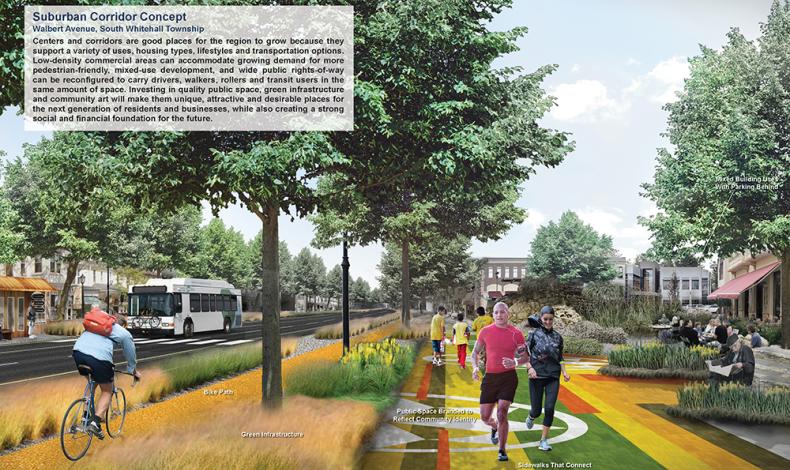Picturing the Future Lehigh Valley

"It’s really exciting to do place-based, speculative work around what the future can look like.”
The Lehigh Valley stretches from the western edge of Lehigh County, Pennsylvania, to the Delaware River in the east, on the border with New Jersey. The valley is surrounded to the north and south by mountains, and its 726 square miles include portions of the Appalachian and Delaware & Lehigh trails, along with more than 120 natural heritage areas. It’s also home to the iconic industrial cities of Allentown and Bethlehem. But despite the Rust Belt narrative of population and job losses, the Lehigh Valley has grown by around 4,000 people every year for the last seven decades. And the development that has accompanied that gradual growth is reaching a tipping point, says Becky Bradley (MCP’03), executive director of the Lehigh Valley Planning Commission. The Valley’s farmlands and vistas no longer appear endless; its small towns are no longer very small.
In December, the LVPC moved toward finalizing a 25-year plan for the region called Future LV. In broad strokes, it calls for densifying existing cities and towns in service of protecting the undeveloped areas that are important to the region’s ecological health and quality of life, while improving transit networks for drivers, bikers, and pedestrians. It’s a non-binding document—its recommendations will be implemented, or not, by more than 60 municipal governments—but it carries the weight of more than $3 billion in federal transportation spending. And because the plan looks ahead to the year 2045, the LVPC wanted to give local officials and residents some vision of what its recommendations might mean.
To mobilize action, Bradley says, “I want to show them a picture, because they can get an idea of what that is—let’s show people what the future could look like.”
To illustrate the transformation of the valley that implementation of the plan would stimulate, the LVPC turned to PennPraxis. Ellen Neises, adjunct associate professor of landscape architecture at the Weitzman School and executive director of PennPraxis, led three studios in the Lehigh Valley, and became acquainted with Bradley and others at the LVPC through that work. PennPraxis was hired as the Design Partner on the Future LV plan in May of 2019, and a team of four Design Fellows spent the summer meeting with Lehigh Valley officials and redesigning a number of places in the Lehigh Valley, in ways that embodied planning and equity goals and demonstrated what attention to design quality could offer. Some of the locations were suggested by the LVPC—a failed mall or major streets in disinvested areas—others were proposed by the Design Fellows as places that represented many locations in the valley—a declining rural village, a shuttered historic industrial complex in need of adaptive reuse, low-quality suburban sprawl.
“[The plan] is intended to be this shared rallying point for everybody,” Neises says. “It’s about building a vision, collectively, with the municipalities.”
Bradley says that the design project had to strike a delicate balance between creating an inspiring vision of the future and respecting private property, taking care to not scare people away with too much change. LVPC asked the team to produce designs at a range of scales, including an aerial view of the entire region, major redevelopments, and human-scaled trails and streetscapes with bike paths and water management infrastructure. Early in their graduate training, the students took up the challenge of using public realm to organize development, and creating housing and other building typologies that would increase design quality within the limits of the local economy.
“The task at hand was imagining a future that’s different from what’s there,” says Andrea McCullough, a second-year MLA student who worked on the project.
The bird’s-eye view, for example, emphasized the natural areas in order to illustrate what was at stake, says Huiyou Ding, another MLA student on the team.
“Realistic but exciting was the line we were trying to walk,” says Melita Schmeckpeper, who is also a second-year MLA student who worked on the project as a PennPraxis intern.
Much of the development that has occurred in the region looks like it could be built anywhere, says McCullough, but LVPC was interested in presenting an ambitious vision for growth that excited people in the local communities. The specificity of the Future LV plan, and the official imprimatur on the document, means the students’ work could influence how the Lehigh Valley develops.
The project was also a chance for students to engage in client-led work at a regional scale, in contrast with the more granular focus of some other landscape architecture studios.
“I’m really interested in pursuing community resilience-building, especially around climate topics,” says McCullough. “That can look like policy, and I think it’s really exciting to do place-based, speculative work around what the future can look like.”
As Praxis Design Fellows, Schmeckpeper and McCullough also designed a public garden at the site where anthracite coal was first burned in a commercially viable furnace—an event that inaugurated the industrial age and “changed the course of the planet,” Neises says.
“They took a really imaginative and poetic approach to this design challenge at the same time that they were thinking about all of these regional planning issues,” Neises says. “To be able to work at both ends of that spectrum is exactly what you want as a young designer.”
Neises considers it an important part of the mission of PennPraxis to create opportunities “beyond the market,” which help Weitzman students develop agency in the world and cultivates the next generation of leaders. With support from Stuart Weitzman and other donors, she was able to expand the Design Fellows program from seven students in 2018 to 21 in 2019, and hopes to continue growing it. Those who wish to support the Design Fellows program may do so online.

